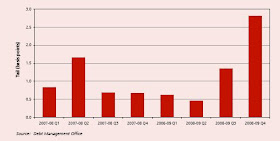
One of the themes running through this blog for the past year has been a howl of protest at the transfer of value to a tiny, over-indulgent section of the world's population. The asset bubble enabled those controlling the world economy to acquire a vast share of the planet's value. Now those who failed to make a killing from some of their risky financial dealings are turning to the prudent and thrifty to make good their losses.
This is the essence of the heartfelt complaint from Graham Beale, chief executive of the Nationwide, at the size of his company's contribution to the financial compensation fund that the FSA require all financial organisations to belong to. Savers who chose the mutual, low-return, low-risk form of financial investment are being required to pay £250m. The FSA regulated building societies tightly, preventing them from joining in the asset bonanza, but now the losses have come home to roost they are expected to compensate those who did.
The Nationwide is required to pay more into the compensation pot than the London-based insurer-of-last-resort Lloyds. The unfairness stems from the fact that the amount levied relates to the amount of retail deposits an institution holds. So, in effect, the mutuals are being punished for being prudent and for having the confidence of small investors. The dealers in footloose venture capital are correspondingly favoured by the scheme, although their chances of needing compensation when risky investments turn sour are higher.
More iniquitous even than the plight of the Nationwide is that of the credit unions, whose members are some of the poorest in our society and whose mission is to encourage thrift and wise management of money amongst those who have least. Each credit union, with its hard-saved and comparatively tiny asset base, is being forced to pay a levy to the fund that insured the gambling of the super-rich.
Despite the temptation to join in the financial frenzy that lured some of the mutuals off their path of virtue, co-operative financial institutions have always operated with prudence and high ethical standards. But, like the credit unions trying to proselytise the catechism of thrift in a world that rewards greed, they must hope that their members have faith that they will get their rewards in heaven since here on earth Mammon seems to have the ear of the regulator.







